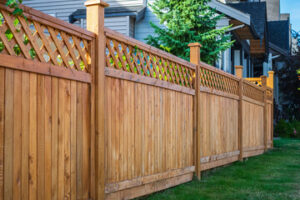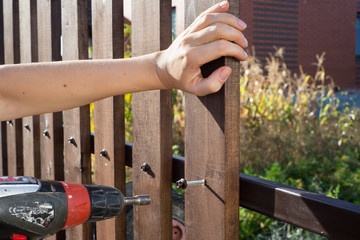Cost of a Wooden Fence
A wooden fence can be a great way to create privacy, keep kids and pets in the yard, and keep deer and other wildlife out. Wooden fences can also be used to protect plants and garden areas.
 To start a wood fence project, homeowners should establish their property lines. They should then design their fence using batter boards and a mason line.
To start a wood fence project, homeowners should establish their property lines. They should then design their fence using batter boards and a mason line.
Cost
A wooden fence can add beauty and value to your home, but it is important to consider the cost before choosing this type of fencing. Wooden fences are usually cheaper than other types of fencing materials, including vinyl, because they do not require as much labor to manufacture. Additionally, wood fences are often made of a more durable material, which increases their lifespan. The durability of a wood fence is also determined by how well it is maintained. Regular cleaning and staining help prevent the development of fungi, which can lead to rot. In addition, staining or sealing protects the wood from the damaging UV rays of the sun.
The cost of a wooden fence depends on the size and height of the fence, as well as the material used. In general, homeowners can expect to pay between $14 and $35 per linear foot for a wooden fence. This includes the cost of materials and installation. Angi lists the following factors that can influence the cost of a wooden fence:
First, you must determine the type of wood you want to use. Cedar and other hardwoods are a good choice because they are durable, attractive, and relatively inexpensive. However, you can also choose less expensive options such as spruce or pine.
Another important factor in the cost of a wooden fence is where it will be located. Homeowners in areas with higher costs of living should expect to pay more for both materials and labor. In addition, you may need to pay extra for delivery and other services.
A wood fence is made of posts and slats that are joined together to create a barrier around your property. The post holes are usually dug into the ground by hand or with a machine called an auger. While it is possible to set the posts in the ground without concrete, it is more stable and durable to use a bag of cement. The bags of cement typically cost between $8 and $10 each.
Depending on the type of wood you select, your fence can be stained or painted for a different look. Staining will protect the wood from damage by UV rays and moisture. Staining will also keep the wood from graying, which can cause it to lose its appeal.
Durability
Wooden fences are a durable option that last for decades if properly maintained. They can withstand the elements and resist rot and insect infestation better than metal fences. However, they require regular maintenance to keep them looking their best. Staining or painting is recommended every two to three years to prevent damage from the sun and water.
The durability of wooden fences depends on the type of wood that is used and how it is treated. Pine is usually the cheapest choice, but it needs to be pressure-treated to protect it from moisture and rot. Cedar, on the other hand, can withstand the elements and is naturally resistant to rot. In addition, it resists insects and fungi, making it an ideal fence material.
Another factor in the durability of a wooden fence is the construction of the rails and posts. These are the connection points for the in-fill panels and boards of the fence. It is important to ensure that the rails are sturdy and well attached to the posts, especially in damp or humid environments. This can help reduce the risk of rot and mold and keep the wood looking its best.
Building a wooden fence can be a great DIY project for experienced homeowners. However, it is important to take the time to plan out the layout before you begin. This will save you time and money in the long run. Also, be sure to use quality power tools and safety equipment to avoid injury. If you are unsure of your ability to handle the job, you may be better off hiring a professional.
Before you begin, check with your local fencing contractor to determine what types of wood are available and the cost of each. This will give you an idea of the type of fence that you can build within your budget. It is also important to find out if there are any restrictions on the style of fence you can build in your neighborhood. Finally, if you live in an HOA, make sure to check with them for any fence restrictions that you must follow.
Styles
Wooden fences come in a variety of materials and designs. Despite the wide range of options, all wood fences share some common components. Understanding these will help you select the best option for your needs and budget. Whether you’re looking for traditional pickets or something more modern, there’s a wooden fence style to suit your taste and budget.
In addition to choosing the material and design of your fence, you’ll need to consider how durable it will be. There are several types of wooden fencing, each with different levels of durability. Some are less expensive than others, but all require maintenance. For example, you’ll need to stain your wooden fence regularly to keep it from rotting and to protect against insect damage. You can also use paint to add color and protect your fence.
A wood fence is a stylish way to define your property line and keep kids, pets, and deer out of your yard. It can be made from pine, spruce, cedar, or cypress, and can be stained or painted to match your home’s décor. You can even choose a natural wood finish that will show off the beauty of the grain.
Another style of wood fence is the split rail. This is a more rustic option that dates back to Colonial days. It uses logs split lengthwise to form the rails, and it’s available in a variety of heights. Split-rail fences are relatively inexpensive, but they provide limited privacy and do not offer much protection for livestock.
While wood fences are less expensive than other types, they’re not as durable as metal or vinyl fences. They also require more maintenance, including cleaning and painting to prevent rot. However, with the right care, your wooden fence will last a long time and will serve its purpose for years to come.
There are many styles of wooden fences, but the most popular are stockade and picket. These types of fences are the most affordable, and can be dressed up with a coat of paint or stain. They are also easy to build and can be installed in a few hours.
Materials
Wooden fences are a popular choice for homeowners, and they can be made of many types of wood. The most common choices include pine, spruce, cedar, and cypress. These materials are rot-resistant and offer good value for the money. They can also be painted or stained in a variety of colors. The cost of a wooden fence is much less than a vinyl or composite one, and the material is renewable. If properly maintained, a wood fence can last for decades.
When choosing a wood fence material, it is important to consider the climate of your area. For example, if you live in a warm region, choose a species of wood that is resistant to mold and mildew growth. In addition, it is important to consider the type of soil where you live. For instance, if your property has sandy or clay soil, you may want to use different types of wood than those recommended for areas with heavy rainfall.
While there are many options available for wood fences, it is essential to choose the right material for your property. First, decide how high you want the fence to be. Then, choose a design that fits your needs and budget. Finally, consult with your HOA or CC&R to ensure that your new fence is within the setback limits.
In most fences, the chief screening component is a series of vertical boards or pickets, called in-fill. These boards can be installed individually by hand, but are more often prefabricated into panels that can be fastened to a rail and post framework already in place. Some manufacturers produce fence panels in six-foot and eight-foot sections, making them easy to transport and install.
Cedar is a popular wood for fences because it has natural oils that repel insects and resist rot. It has a pleasing natural look, and it can be stained to match your home’s style. However, it is more expensive than low-range pine.
Cypress is another rot-resistant option that can be used to build fences. Its natural oils make it a good choice for stains and finishes, but it is not as long-lasting as western red cedar. Moreover, it is often shipped from the south, which increases its overall price tag.

